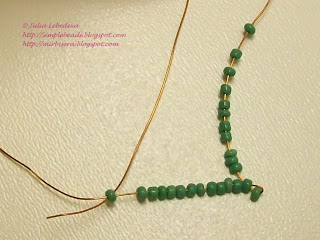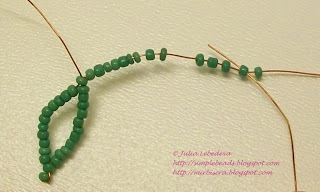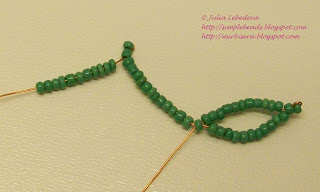Today we will make a beaded sunflower out of seed beads and wire.
We will need:
- size 11 seed beads of yellow and green colors,
- size 8 seed beads of black color,
- wire 0.3 mm thick for basic weaving,
- wire 0.2 mm thick for assembling the flower;
- green thread for winding the stem.
At first, out of yellow seed beads make the flower’s petals.
For the each petal take a piece of wire 70 cm long (the longer wire you will take, the longer the stem of the flower turns to be).
Weave the petal using the parallel weaving technique and the following pattern:
1st row - 2 beads,
2nd row - 3 beads,
3rd row - 4 beads,
rows 4th and 5th - 5 beads each,
rows from 6th till 8th - 6 beads each,
9th row - 5 beads,
10th row - 4 beads,
11th row - 3 beads,
12th row - 2 beads.
For your convenience twist together both ends of the wire under the petal.
You should make 20 such petals for the each flower.
Next, out of black seed beads make the central part of the flower. I made it using teardrop seed beads but you can use usual round seed beads.
To make the central part of the flower use the weaving technique that we previously used for making a beaded table, with only small differences.
Take a piece of wire 80 cm long and make two rows of 2 beads in the each row. Place these rows on the middle of the wire.
Then around these rows make circles of beads consisting of two halves each.
The each half of the first circle consists of 7 beads.
The each half of the second circle consists of 11 beads.
The each half of the third circle consists of 17 beads.
The each half of the fourth circle consists of 21 beads.
The each half of the fifth circle consists of 28 beads.
Next, bend the ends of the wire towards the center of the circle and after that twist them together.
Doing so, try the beaded circle to stay straight and flat.
Next, out of green seed beads make the sepals.
Take a piece of wire 70 cm long and string 14 beads on it. Place the set of beads on the middle of the wire.
Hold the extreme bead at any end of the wire and pass this end of the wire backwards through the next bead.
Tighten the wire trying to keep the beads on the middle of the wire.
Then string 11 beads on the same end of the wire
and pass it backwards through the last bead on the other end of the wire.
Tighten the wire. We’ve got the first sepal.
Continue making sepals on the same wire. String on any end of the wire 14 beads,
hold the last added bead and pass this end of the wire backwards through the next bead.
Move all the beads close to the first sepal and tighten the wire.
Then string 11 beads on the same end of the wire
and pass it backwards through the bead that is closest to the first sepal.
Tighten the wire. We’ve got the second sepal.
Then make three more such sepals on the same end of the wire and after that make four such sepals on the other end of the wire. Now we have nine sepals in total.
Next, out of green seed beads make the flower’s leaves. The each leaf consists of two halves, for the each of which take a wire 70 cm long.
The first half of the leaf make in flat parallel weaving using the following pattern:
1st row - 1 bead,
2nd row - 2 beads,
3rd row - 3 beads,
4th row - 4 beads,
5th row - 5 beads,
6th row - 6 beads,
7th row - 7 beads,
8th row - 8 beads,
rows from 9th till 14th - 9 beads each,
15th row - 8 beads,
16th row - 7 beads,
17th row - 6 beads,
18th row - 5 beads,
19th row - 4 beads,
20th row - 3 beads,
21st row - 2 beads,
22nd row - 1 bead.
When making the second half of the leaf, plait the each row of it to the first half.
Take a piece of wire for the second half of the leaf and pass it between the 1st and the 2nd rows of the first half of the leaf.
Pull this wire so that its ends are of equal length. Then make the 1st row of the second half of the leaf, consisting of 1 bead.
After that pass one end of the wire of the second half of the leaf between the 2nd and the 3rd rows of the first half
and after that make the 2nd row of the second half of the leaf, consisting of 2 beads.
Keep on making the rows of the second half of the leaf in the same way. Do not forget to plait the wire of the second half of the leaf to the first half before the each new row.
Use the following pattern:
3rd row - 3 beads,
4th row - 4 beads,
5th row - 5 beads,
6th row - 6 beads,
7th row - 7 beads,
8th row - 8 beads,
rows from 9th till 13th - 9 beads each,
14th row - 8 beads,
15th row - 7 beads,
16th row - 6 beads,
17th row - 5 beads,
18th row - 4 beads,
19th row - 3 beads,
20th row - 2 beads,
21st row - 1 bead.
After finishing the leaf twist together all the wires under it.
For the each flower make at least two such leaves.
Weaving is completed, now start assembling the flower.
Take an additional piece of thin wire 50 cm long and pass it through the last row of all the 20 petals.
Place the petals on the middle of this wire.
Gather all the petals into a tight circle and twist together both ends of the additional wire. Do not twist together all the wires under the petals at the moment.
Then take the central part of the flower and insert it into the center of the circle of petals.
Move the central part of the flower close to the petals
and twist together all the ends of the wires.
After that take the sepals, place them right under the flower around the stem,
twist together both ends of the wire from the sepals
and then twist this wire around the stem.
Now take a green thread and wind it round the stem for some distance (till the place where the first leaf will be attached).
Then attach leaves to the stem, placing them around the stem at some distance from the each other.
At the same time continue winding the stem by a green thread to hide the wire.
Complete winding the stem by a green thread at its full length.
Now secure the thread by making a knot, trim the excess wires at the bottom of the stem if needed and straighten the petals.
The beaded sunflower is finished!
To get a bouquet of sunflowers I made 3 such flowers and put them into a vase.
P.S. If you like this tutorial, share it with your friends on social networks using the buttons below the post.
Don't want to miss new tutorials? Subscribe for email notifications of site updates or follow us on Twitter!














































No comments:
Post a Comment